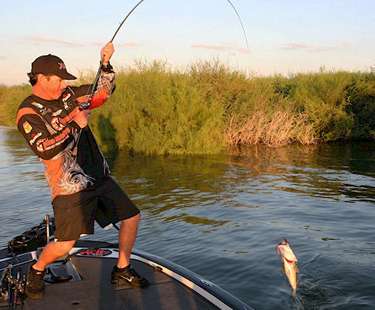
When it comes to selecting the right plastic bait, there are endless choices. Color, size, shape, consistency, and durability all play a factor in the equation.
Even then, modifications are often made to the plastic. A little dye, a pinch here, trim there, and it becomes a customized creation. In the search for the perfect plastic, many anglers overlook the fact that customizing their hook is just as important to finding success on the water.
"A lot of people will grab a hook out of the package thinking that it's sharp, it matches the bait, and it creates a good overall profile," says Elite Series pro Grant Goldbeck. "But that's not the most important thing they should be paying attention to."
The Maryland pro who recently relocated to Texas says that the position of the hook point and the distance between the shank of the hook and the plastic bait are the two most important factors when selecting a hook. "I really don't care whether or not I can hook the fish," he states. "I focus on how well I can hook the fish and how often I can get that fish in the boat."
For Goldbeck, his worm hook choice centers around percentage and execution — the higher percentage of bites that turn into boated bass, the better the hook. With this in mind, Goldbeck has developed a technique to increase his strike-to-land ratio with standard extra wide gap worm hooks.
It involves a pair of pliers, a steady hand, and a keen eye.
Taking a standard Gamakatsu 5/0 Extra Wide Gap worm hook out of the package, he bends the point of the hook outward and then begins to mold the shaft of the hook in order to create an even wide gap. "I think the biggest factor is to get the point of the hook above the eye of the hook.
A lot of hook manufactures don't make them that way, especially with the extra-wide gap hooks. "I like to reshape the whole hook and raise the point up so that it's not in line with the eye of the hook," Goldbeck says. "It creates a better bite, so when you set the hook it penetrates the roof of the mouth instead of pulling into the corner. It allows the hook to penetrate a lot deeper."
Increasing hook penetration is the main objective to Goldbeck's modifications. He says that when properly modified, a standard 5/0 hook will turn into a 7/0 hook and a standard 4/0 hook will resemble a 6/0 hook. "You have to remember that when you expand the gap in the hook, what you're doing is basically increasing the size of that hook," he says. Since he has started modifying light wire extra wide gap hooks, Goldbeck says he has seen a dramatic increase in the number of bass he lands.
"I've had a history of losing fish in tournaments, so I've really started to study hooks and line more than anything else. The general thought is that a light wire hook will straighten out. If you're using the right equipment, that's just not true.
The light wire is going to stick and stay." When fishing 10-inch worms in 15 to 35 feet of water, Goldbeck uses a 7-6 medium-heavy Pinnacle rod and matches it with either 16- or 20-pound-test Sunline fluorocarbon line. "After I started modifying my worm hooks, structure fishing has become the one technique that I have total confidence in," says Goldbeck. "With a crankbait, I'm always nervous about losing one. When I pick up that big worm on a modified hook, I know that the fish will end up in the boat."
(Provided by Z3 Media)




